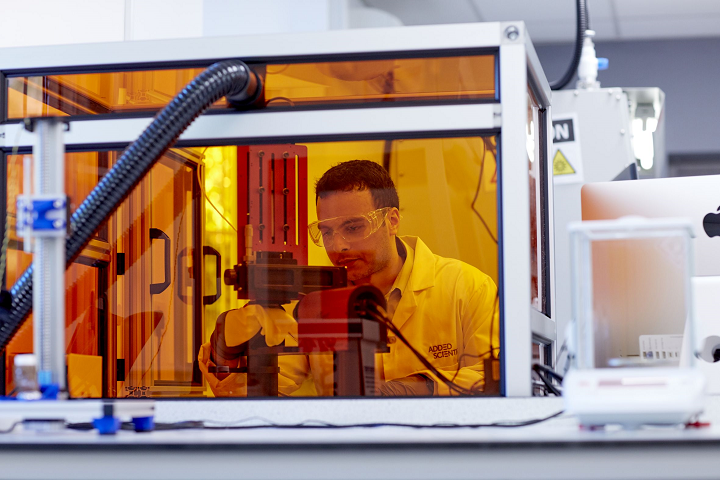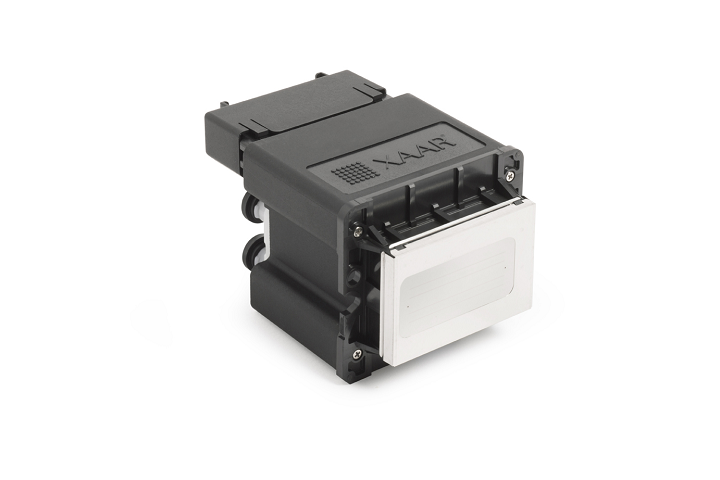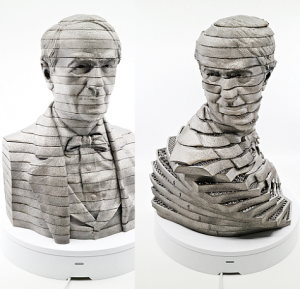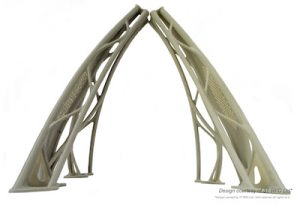3D Printing Industry Review of the year: January 2019
Added Scientific Used Xaar Printhead in Pilot Project for 3D Printing Personalized Pharmaceuticals
Cambridge-based company Xaar may have had its start in developing piezoelectric, drop-on-demand industrial printheads, but transitioned to the 3D printing world back in 2014 when it helped develop the high speed sintering (HSS) FACTUM 3D printer. Xaar is also a leading developer of digital inkjet printing technology, and is currently helping research organization Added Scientific, headquartered in Nottingham, as it works to determine how suitable inkjet printing is in fabricating personalized pharmaceuticals.
Added Scientific, a spinoff company from the University of Nottingham, is using Xaar’s 1201 printhead to bring personalized medicine, with dosages tailored to individual people on an industrial scale, just one step closer to reality.
Craig Sturgess, Research Manager for Added Scientific, said, “Inkjet printing offers the ability to digitally control the printing with its precision placement of tiny droplets a few picolitres in size and the capability to place multiple materials to create complex multi-functional objects in 2D & 3D.
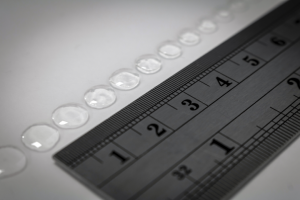 The project was initiated by Added Scientific with its collaborating partners Xaar and global pharmaceutical company AstraZeneca and funded under the UK government’s Industrial Strategy Challenge Fund’s Medicines Manufacturing Challenge, with additional support from Innovate UK. They’re building on research previously conducted at the university regarding the development of excipients: everything but the active pharmaceutical ingredient (API). This pilot project is looking at the long-term suitability and scalability of using inkjet printing to dispense APIs.
The project was initiated by Added Scientific with its collaborating partners Xaar and global pharmaceutical company AstraZeneca and funded under the UK government’s Industrial Strategy Challenge Fund’s Medicines Manufacturing Challenge, with additional support from Innovate UK. They’re building on research previously conducted at the university regarding the development of excipients: everything but the active pharmaceutical ingredient (API). This pilot project is looking at the long-term suitability and scalability of using inkjet printing to dispense APIs.
“Trial research carried out previously has shown that inkjet offers a real potential for printed medicines. This project was designed to answer questions pharmaceutical companies have around the suitability of inkjet printing in dispensing APIs at a scale that made both manufacturing and economic sense,” Sturgess continued.
The project partners used the Xaar 1201 printhead with one of the university’s formulations to evaluate its impact on the API, in addition to how well it can operate under Good Manufacturing Practice (GMP) conditions. GMP is the de facto standard for manufacturing in the pharmaceutical industry. They also studied if the formulation had an effect on the life of the printhead, and rounded out their experimental trials by evaluating AstraZeneca’s data from conventional tablet manufacturing against inkjet printing process times.
“The Xaar 1201 is ideal for a wide range of industrial applications including Advanced Manufacturing due to its ability to print fluids with a range of viscosities, reactivity and conductivity. This pilot project has demonstrated the Xaar 1201’s versatility for pharmaceuticals and how inkjet printing is proving itself to have the potential to drive innovation as well as efficiencies in many areas of 21 st century life,” stated Mike Seal, Business Development Manager, Advanced Manufacturing, at Xaar.
The results from the team’s project showed significant time saved in unit process times from inkjet printing in comparison to conventional manufacturing methods. Production trials consisted of 1,000 dosage forms printed in batches of 100, and no issues or interaction with the API occurred in Xaar’s 1201 printhead; additionally, there was no impact on the life of the printhead itself.
“These are exciting times. Our project has clearly shown that printing personalised medicines – with all their advantages of dose and design freedom – is no longer just a theory, but a scalable and economic reality for pharmaceutical companies and we look forward to extended trials to confirm these findings,” Sturgess concluded.
Added Scientific and its project partners are certainly not the first to investigate the idea of using 3D printing to fabricate personalized medication, and I doubt they will be the last. However, inkjet printing is not typically used to make 3D printed medication, so it will be interesting to see what the team’s next steps will be.
Discuss this story and other 3D printing topics at 3DPrintBoard.com or share your thoughts in the Facebook comments below.
[Images: Xaar]
Innovate UK opens €2 million funding competition for photonics research
Founder of Gravity Sketch recognized as one of UK’s most innovative women
ASTM International, Innovate UK, BSI & MTC to co-develop standards metal additive manufacturing
Photocentric: Using LCD Screens for Resin-Based 3D Printing
Far more than just a device able to make calls, send emails, play music, take pictures, and share those pictures on social media, cell phones are capable of amazing feats when paired with 3D printing. They can be turned into microscopes and other medical devices, and even be used to power a 3D printer. But another trend that’s picking up steam is using your smartphone as an actual 3D printer.
Back in 2015, researchers from MIT were working to develop new algorithms that could harness polarized light from smartphones for 3D printing. That very same year, we first heard about the OLO (now called the ONO), the world’s first smartphone 3D printer. 2015 was clearly an important time for this type of work, as a professor of mechanical engineering at Taiwan Tech also created a smartphone-based 3D printer that year. In just about all of these cases, light emanating from the phone’s screen was used to cure resin, rather than using UV lights.
 So now it’s 2018 – what’s going on with smartphone 3D printers today? Specialist chemical manufacturer Photocentric, founded back in 2002 and specializing in visible light photopolymerization, manufactures the Liquid Crystal range of 3D printers and commercialized the first 3D printer based on an LCD screen two years ago.
So now it’s 2018 – what’s going on with smartphone 3D printers today? Specialist chemical manufacturer Photocentric, founded back in 2002 and specializing in visible light photopolymerization, manufactures the Liquid Crystal range of 3D printers and commercialized the first 3D printer based on an LCD screen two years ago.
“Instead of using a laser or a projector to cure the polymer, we use unmodified LCD screens and our specially formulated Daylight polymer,” the company’s website reads. “All other 3D printers that polymerise resin use a combination of both daylight and UV light at considerably higher intensities. We have been able to make this work by developing the world’s most sensitive daylight resins. Utilising mass produced screens designed for use in mobiles, handheld devices enable us to use the highest resolution screens, offering phenomenal value for money, which we can then pass on to our customers. The opportunities are limitless; higher and higher resolution screens becoming available in all formats from mobiles to large format televisions provide the lowest cost imaging systems ever imagined. We call this Daylight Polymer Printing.”
While 3D printing is used for both small-scale and large-scale manufacturing across many industries, Photocentric, which holds patents in visible light curing technologies, believes that the technology still costs too much to be adopted on a wide scale. That’s why the company is focused on using the LCD screens we interact with every day on our TVs, smartphones, laptops, and tablets to transform 3D printing and make it less expensive.
To 3D print an object with resin-based 3D printers, the material is typically cured and hardened with a laser, or a digital light projector. But Photocentric is using LCD screen illumination to lower the cost of 3D printing, so that the technology can be used in more applications.
Photocentric’s photopolymer research has been supported by grants from Innovate UK and private industry ever since the company first opened its doors. Its initial idea was to package light-sensitive liquids in sachets in order to make stamps for applications in crafting and office work, and the company took the necessary next step in developing small-scale equipment to process the packs to create stamps – this won Photocentric a Queen’s award in 2016 and a second one this year for its “outstanding growth in overseas sales.”
The company, which employs 90 people at its Peterborough location, will reportedly have sales of over £7 million in the UK by the end of the year. Its US subsidiary in Arizona, which has 35 additional employees, should add to that sales number by £3 million. The company is certainly very ambitious and optimistic about its chances.
“Our aim is to hit £100 million in 5 years and be the largest manufacturer of photopolymer for 3D printing in the world,” said Holt.
Now, Photocentric is totally focused on powering 3D printing using the illumination from LCD screens, mostly from the visible part of the spectrum, which is required when it comes to visual display screens. This could be the future of industrial 3D printing someday.
“Today it seems obvious that the highest resolution, largest format and lowest cost digital light source available is the visual display screen we all use in our pockets or on our walls,” said Paul Holt, the Founder of Photocentric. “But it can only work in 3D printing because our photopolymers can harden in light within the visible spectrum.
“We are now doing research into all formats of 3D printers with LCD screens from the nano – using tiny screens from near-eye virtual reality headsets – through to mobiles, tablets, right up to the largest TV screens. In fact, we just won a grant to manufacture what will be the largest 3D printer in the world, based on a 98-inch HDTV screen. Our goal is to change world manufacturing, not just 3D printing, by making 3D printing low cost, large scale and functional.”
In terms of making the technology more affordable, there are millions of LED screens manufactured by the electronics industry. It seems like nearly every quarter, cell phone, tablet, and TV screens change in size and affordability. If this industry takes its cue from Photocentric and focuses its R&D efforts on using these screens for 3D printing, the technology will inevitably become less expensive.
However, don’t expect to use your cell phone’s LCD screen to make large 3D printed objects. Regardless of how ingenious the idea is, the light output will likely be pretty low, and not enough to fabricate big parts. But it could be helpful when 3D printing lots of smaller objects.
As for Photocentric’s next steps? The company is now looking at metal 3D printing.
“This time we are using light and a binder to fix the shape of a metal rich formulation using light from LCD screens,” Holt explained. “The object will then be slowly heated to remove the binder and sinter (fuse together) the metal. This technology can then be applied to all small-volume manufacturing of metal parts.”
While 3D printing in metal could eventually have a major impact on materials manufacturing, the 3D printing work that Photocentric is doing with metals is still mostly confined to the lab and is not a working solution just yet.
Discuss this story and other 3D printing topics at 3DPrintBoard.com or share your thoughts below.
AMT launches automated PostPro3D smoothing system for additive manufacturing
3D Printing News Briefs: August 24, 2018
We’re sharing some business news in today’s 3D Printing News Briefs, followed by some interesting research and a cool 3D printed statue. Meld was listed as a finalist in the R&D 100 Awards, and Renishaw has introduced 3D printed versions to its styli range, while there’s an ongoing Digital Construction Grant competition happening in the UK. A researcher from Seoul Tech published a paper about in situ hydrogel in the field of click chemistry, while researchers in Canada focused on the Al10SiMg alloy for their study. Finally, an Arcam technician tested the Q20plus EBM 3D printer by making a unique titanium statue of Thomas Edison.
Meld is R&D 100 Awards Finalist
 The global R&D 100 Awards have gone on for 56 years, highlighting the top 100 innovations each year in categories including Process/Prototyping, IT/Electrical, Mechanical Devices/Materials, Analytical/Test, and Software/Services, in addition to Special Recognition Awards for things like Green Tech and Market Disruptor Products. This year, over 50 judges from various industries selected finalists for the awards, one of which is MELD Manufacturing, an already award-winning company with a unique, patented no-melt process for altering, coating, joining, repairing, and 3D printing metal.
The global R&D 100 Awards have gone on for 56 years, highlighting the top 100 innovations each year in categories including Process/Prototyping, IT/Electrical, Mechanical Devices/Materials, Analytical/Test, and Software/Services, in addition to Special Recognition Awards for things like Green Tech and Market Disruptor Products. This year, over 50 judges from various industries selected finalists for the awards, one of which is MELD Manufacturing, an already award-winning company with a unique, patented no-melt process for altering, coating, joining, repairing, and 3D printing metal.
“Our mission with MELD is to revolutionize manufacturing and enable the design and manufacture of products not previously possible. MELD is a whole new category of additive manufacturing,” said MELD Manufacturing Corporation CEO Nanci Hardwick. “For example, we’re able to work with unweldable materials, operate our equipment in open-atmosphere, produce much larger parts that other additive processes, and avoid the many issues associated with melt-based technologies.”
The winners will be announced during a ceremony at the Waldorf Astoria in Orlando on November 16th.
Renishaw Introduces 3D Printed Styli
 This month, Renishaw introduced a 3D printed stylus version to its already wide range of available styli. The company uses its metal powder bed fusion technology to provide customers with complex, turnkey styli solutions in-house, with the ability to access part features that other styli can’t reach. 3D printing helps to decrease the lead time for custom styli, and can manufacture strong but lightweight titanium styli with complex structures and shapes. Female titanium threads (M2/M3/M4/M5) can be added to fit any additional stylus from Renishaw’s range, and adding a curved 3D printed stylus to its REVO 5-axis inspection system provides flexibility when accessing a component’s critical features. Components with larger features need a larger stylus tip, which Renishaw can now provide in a 3D printed version.
This month, Renishaw introduced a 3D printed stylus version to its already wide range of available styli. The company uses its metal powder bed fusion technology to provide customers with complex, turnkey styli solutions in-house, with the ability to access part features that other styli can’t reach. 3D printing helps to decrease the lead time for custom styli, and can manufacture strong but lightweight titanium styli with complex structures and shapes. Female titanium threads (M2/M3/M4/M5) can be added to fit any additional stylus from Renishaw’s range, and adding a curved 3D printed stylus to its REVO 5-axis inspection system provides flexibility when accessing a component’s critical features. Components with larger features need a larger stylus tip, which Renishaw can now provide in a 3D printed version.
“For precision metrology, there is no substitute for touching the critical features of a component to gather precise surface data,” Renishaw wrote. “Complex parts often demand custom styli to inspect difficult-to-access features. AM styli can access features of parts that other styli cannot reach, providing a flexible, high-performance solution to complex inspection challenges.”
Digital Construction Grant Competition
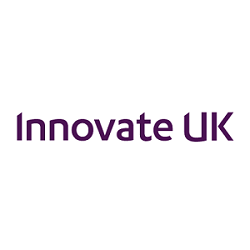 Recently, a competition opened up in the UK for organizations in need of funding to help increase productivity, performance, and quality in the construction sector. As part of UK Research and Innovation, the organization Innovate UK – a fan of 3D printing – will invest up to £12.5 million on innovative projects meant to help improve and transform construction in the UK. Projects must be led by a for-profit business in the UK, begin this December and end up December of 2020, and address the objectives of the Industrial Strategy Challenge Fund on Transforming Construction. The competition is looking specifically for projects that can improve the construction lifecycle’s three main stages:
Recently, a competition opened up in the UK for organizations in need of funding to help increase productivity, performance, and quality in the construction sector. As part of UK Research and Innovation, the organization Innovate UK – a fan of 3D printing – will invest up to £12.5 million on innovative projects meant to help improve and transform construction in the UK. Projects must be led by a for-profit business in the UK, begin this December and end up December of 2020, and address the objectives of the Industrial Strategy Challenge Fund on Transforming Construction. The competition is looking specifically for projects that can improve the construction lifecycle’s three main stages:
- Designing and managing buildings through digitally-enabled performance management
- Constructing quality buildings using a manufacturing approach
- Powering buildings with active energy components and improving build quality
Projects that demonstrate scalable solutions and cross-sector collaboration will be prioritized, and results should lead to a more streamlined process that decreases delays, saves on costs, and improves outputs, productivity, and collaborations. The competition closes at noon on Wednesday, September 19. You can find more information here.
Click Bioprinting Research
 Researcher Janarthanan Gopinathan with the Seoul University of Science Technology (Seoul Tech) published a study about click chemistry, which can be used to create multifunctional hydrogel biomaterials for bioprinting ink and tissue engineering applications. These materials can form 3D printable hydrogels that are able to retain live cells, even under a swollen state, without losing their mechanical integrity. In the paper, titled “Click Chemistry-Based Injectable Hydrogels and Bioprinting Inks for Tissue Engineering Applications,” Gopinathan says that regenerative medicine and tissue engineering applications need biomaterials that can be quickly and easily reproduced, are able to generate complex 3D structures that mimic native tissue, and be biodegradable and biocompatible.
Researcher Janarthanan Gopinathan with the Seoul University of Science Technology (Seoul Tech) published a study about click chemistry, which can be used to create multifunctional hydrogel biomaterials for bioprinting ink and tissue engineering applications. These materials can form 3D printable hydrogels that are able to retain live cells, even under a swollen state, without losing their mechanical integrity. In the paper, titled “Click Chemistry-Based Injectable Hydrogels and Bioprinting Inks for Tissue Engineering Applications,” Gopinathan says that regenerative medicine and tissue engineering applications need biomaterials that can be quickly and easily reproduced, are able to generate complex 3D structures that mimic native tissue, and be biodegradable and biocompatible.
“In this review, we present the recent developments of in situ hydrogel in the field of click chemistry reported for the tissue engineering and 3D bioinks applications, by mainly covering the diverse types of click chemistry methods such as Diels–Alder reaction, strain-promoted azide-alkyne cycloaddition reactions, thiol-ene reactions, oxime reactions and other interrelated reactions, excluding enzyme-based reactions,” the paper states.
“Interestingly, the emergence of click chemistry reactions in bioink synthesis for 3D bioprinting have shown the massive potential of these reaction methods in creating 3D tissue constructs. However, the limitations and challenges involved in the click chemistry reactions should be analyzed and bettered to be applied to tissue engineering and 3D bioinks. The future scope of these materials is promising, including their applications in in situ 3D bioprinting for tissue or organ regeneration.”
Analysis of Solidification Patterns and Microstructural Developments for Al10SiMg Alloy
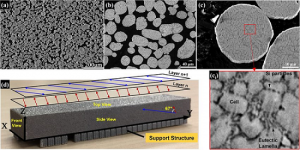
a) Secondary SEM surface shot of Al10SiMg powder starting stock, (b) optical micrograph and (c) high-magnification secondary SEM image of the cross-sectional view of the internal microstructure with the corresponding inset shown in (ci); (d) the printed sample and schematic representation of scanning strategy; The bi-directional scan vectors in Layer n+1 are rotated by 67° counter clockwise with respect to those at Layer n.
A group of researchers from Queen’s University and McGill University, both in Canada, explain the complex solidification pattern that occurs during laser powder bed fusion 3D printing of the Al10SiMg alloy in a new paper, titled “Solidification pattern, microstructure and texture development in Laser Powder Bed Fusion (LPBF) of Al10SiMg alloy.”
The paper also characterizes the evolution of the α-Al cellular network, grain structure and texture development, and brought to light many interesting facts, including that the grains’ orientation will align with that of the α-Al cells.
The abstract reads, “A comprehensive analysis of solidification patterns and microstructural development is presented for an Al10SiMg sample produced by Laser Powder Bed Fusion (LPBF). Utilizing a novel scanning strategy that involves counter-clockwise rotation of the scan vector by 67° upon completion of each layer, a relatively randomized cusp-like pattern of protruding/overlapping scan tracks has been produced along the build direction. We show that such a distribution of scan tracks, as well as enhancing densification during LPBF, reduces the overall crystallographic texture in the sample, as opposed to those normally achieved by commonly-used bidirectional or island-based scanning regimes with 90° rotation. It is shown that, under directional solidification conditions present in LPBF, the grain structure is strictly columnar throughout the sample and that the grains’ orientation aligns well with that of the α-Al cells. The size evolution of cells and grains within the melt pools, however, is shown to follow opposite patterns. The cells’/grains’ size distribution and texture in the sample are explained via use of analytical models of cellular solidification as well as the overall heat flow direction and local solidification conditions in relation to the LPBF processing conditions. Such a knowledge of the mechanisms upon which microstructural features evolve throughout a complex solidification process is critical for process optimization and control of mechanical properties in LPBF.”
Co-authors include Hong Qin, Vahid Fallah, Qingshan Dong, Mathieu Brochu, Mark R. Daymond, and Mark Gallerneault.
3D Printed Titanium Thomas Edison Statue
Oskar Zielinski, a research and development technician at Arcam EBM, a GE Additive company, is responsible for maintaining, repairing, and modifying the company’s electron beam melting (EBM) 3D printers. Zielinski decided that he wanted to test out the Arcam EBM Q20plus 3D printer, but not with just any old benchmark test. Instead, he decided to create and 3D print a titanium (Ti64) statue of Thomas Edison, the founder of GE. He created 25 pieces and different free-floating net structures inside each of the layers, in order to test out the 3D printer’s capabilities. All 4,300 of the statue’s 90-micron layers were 3D printed in one build over a total of 90 hours, with just minimal support between the slices’ outer skins.
The statue stands 387 mm tall, and its interior net structures show off the kind of complicated filigree work that EBM 3D printing is capable of producing. In addition, Zielinski also captured a time lapse, using an Arcam LayerQam, from inside the 3D printer of the statue being printed.
“I am really happy with the result; this final piece is huge,” Zielinski said. “I keep wondering though what Thomas Edison would have thought if someone would have told him during the 19th century about the technology that exists today.”
Discuss these stories and other 3D printing topics at 3DPrintBoard.com or share your thoughts below.
Victrex Introduces New PAEK 3D Printing Materials
 UK company Victrex has been a material supplier for more than three decades, specializing in high performance, high-temperature materials, in particular, PEEK part of the PAEK family of materials. Now the company has developed new materials for additive manufacturing, including a high strength polyaryletherketone (PAEK) material for laser sintering. PAEKs have high-temperature stability and high mechanical strength and is often used in medical and engineering applications. Victrex’s new laser sintering material attains lower refresh rates, resulting in improved recycling for unsintered powder. The second new material is a PAEK FDM/FFF filament with better strength and better printability than existing PAEK materials.
UK company Victrex has been a material supplier for more than three decades, specializing in high performance, high-temperature materials, in particular, PEEK part of the PAEK family of materials. Now the company has developed new materials for additive manufacturing, including a high strength polyaryletherketone (PAEK) material for laser sintering. PAEKs have high-temperature stability and high mechanical strength and is often used in medical and engineering applications. Victrex’s new laser sintering material attains lower refresh rates, resulting in improved recycling for unsintered powder. The second new material is a PAEK FDM/FFF filament with better strength and better printability than existing PAEK materials.
“These next-generation Victrex PAEK materials for additive manufacturing mark a decisive step forward, having potential to transform multiple applications, including aerospace, medical, and electronics,” said Victrex CEO Jakob Sigurdsson. “The exciting progress is based on continued intense R&D at Victrex and excellent collaboration within the Victrex-led consortium of companies and institutions pursuing innovation in additive manufacturing. Through this consortium we’re already seeing demonstrator parts that show how AM processes, coupled with high-performance materials, transform thinking to create truly innovative parts based on increased design possibilities.”
PAEK is mainly used in manufacturing technologies like machining and injection molding. Thus far, it hasn’t been an ideal material for additive manufacturing. When used in laser sintering, it tends to only be able to be recycled at a very low rate, and needs nearly a full refresh of the printing bed with new powder. In FDM 3D printing, it has poor interlayer bonding, resulting in a loss of Z strength. Victrex’s new materials address these issues in particular, making them highly recyclable and printable, respectively, with good mechanical properties.
“Breakthrough technology is paving the way for an exciting future for additive manufacturing [using] PAEK,” said John Grasmeder, Chief Scientist at Victrex. “The powder recycle work for laser sintering, using the new Victrex development polymer grades has gone very well, with no measurable loss of properties when test components were made from partially recycled powder. We believe it will be possible to re-use all of the non-sintered powder that is recovered after a build run. This will result in a significant reduction in material costs compared to current PAEK materials where up to 40% of the polymer is wasted and cannot be recycled.”
 In 2016, the UK’s innovation agency, Innovate UK, awarded funding to a consortium led by Victrex to carry out research and development for the advancement of 3D printing technologies, particularly affordable high-temperature composites for 3D printed aerospace applications. The other members of the consortium are Airbus Group Innovations, EOS, CALM, E3D-Online, HiETA Technologies, South West Metal Finishing, and 3T-RPD.
In 2016, the UK’s innovation agency, Innovate UK, awarded funding to a consortium led by Victrex to carry out research and development for the advancement of 3D printing technologies, particularly affordable high-temperature composites for 3D printed aerospace applications. The other members of the consortium are Airbus Group Innovations, EOS, CALM, E3D-Online, HiETA Technologies, South West Metal Finishing, and 3T-RPD.
Victrex’s new materials complement the other technologies developed by members of the consortium. For example, EOS recently introduced the EOS P 500, an industrial, automation-ready laser sintering platform capable of producing high temperature, high-performance materials. Some of the materials being developed by the consortium are being evaluated at EOS research and development facilities for processability on current EOS systems, as well as the EOS P 500.
Victrex is also planning to continue pre-commercial testing of its new PAEK filament with E3D, which recently commercially released a new water-cooled extruder head especially optimized for the filament.
Discuss this and other 3D printing topics at 3DPrintBoard.com or share your thoughts below.
[Source: Plastics Today]

